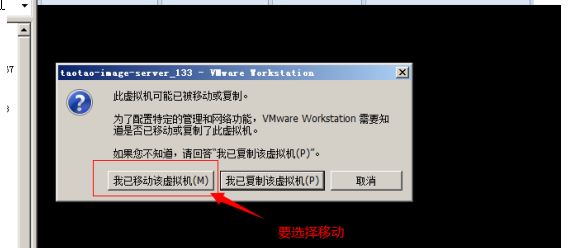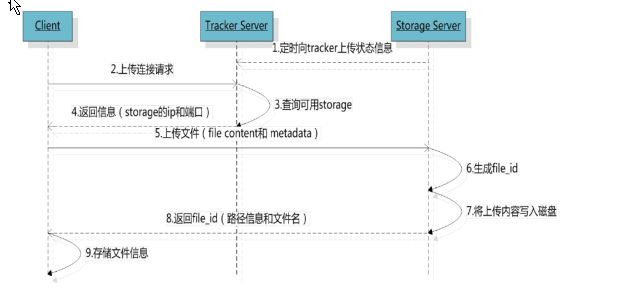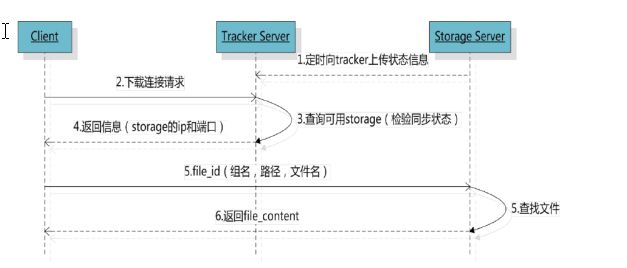FastDFS介绍
FastDFS是用c语言编写的一款开源的分布式文件系统。FastDFS为互联网量身定制,充分考虑了冗余备份、负载均衡、线性扩容等机制,并注重高可用、高性能等指标,使用FastDFS很容易搭建一套高性能的文件服务器集群提供文件上传、下载等服务。
FastDFS架构
FastDFS架构包括 Tracker server和 Storage server。客户端请求Tracker server进行文件上传、下载,通过Tracker server调度最终由Storage server完成文件上传和下载。
Tracker server作用是负载均衡和调度,通过Tracker server在文件上传时可以根据一些策略找到Storage server提供文件上传服务。可以将tracker称为追踪服务器或调度服务器。
Storage server作用是文件存储,客户端上传的文件最终存储在Storage服务器上,Storage server没有实现自己的文件系统而是利用操作系统 的文件系统来管理文件。可以将storage称为存储服务器。
架构图
架构说明:
服务端两个角色:
Tracker:管理集群,tracker也可以实现集群。每个tracker节点地位平等。收集Storage集群的状态。
Storage:实际保存文件,Storage分为多个组,每个组之间保存的文件是不同的。每个组内部可以有多个成员,组成员内部保存的内容是一样的,组成员的地位是一致的,没有主从的概念。
FastDFS的安装
这个图片服务器的安装方法有点儿麻烦(安装手册见左边栏的链接)
下面直接提供一个安装好FastDFS的虚拟机文件,开机就能用(服务都是自启动的)(虚拟机文件也见左边栏的链接)
注意:在虚拟机放到VMware中后,启动的时候,会弹出一个对话框,如下图
说明:
移动:网络配置不发生变化。要使用图片服务器,需要保证网络配置不变。
复制:重新生成一块网卡mac地址是新地址。
对于开发人员来说,我们只需熟悉其上传、下载的流程以及Java客户端的使用方法。
上传流程:
客户端上传文件后存储服务器将文件ID返回给客户端,此文件ID用于以后访问该文件的索引信息。文件索引信息包括:组名,虚拟磁盘路径,数据两级目录,文件名。
即:![]()
目录的说明:
组名:文件上传后所在的storage组名称,在文件上传成功后有storage服务器返回,需要客户端自行保存。
虚拟磁盘路径:storage配置的虚拟路径,与磁盘选项store_path*对应。如果配置了store_path0则是M00,如果配置了store_path1则是M01,以此类推。
数据两级目录:storage服务器在每个虚拟磁盘路径下创建的两级目录,用于存储数据文件。
文件名:与文件上传时不同。是由存储服务器根据特定信息生成,文件名包含:源存储服务器IP地址、文件创建时间戳、文件大小、随机数和文件拓展名等信息。
下载流程:
Java客户端的使用
@Test
public void testUpload() throws Exception {
//创建一个配置文件。文件名任意。内容就是tracker服务器的地址。
//使用全局对象加载配置文件。
ClientGlobal.init("D:/workspaces-itcast/JavaEE32/e3-manager-web/src/main/resources/conf/client.conf");
//创建一个TrackerClient对象
TrackerClient trackerClient = new TrackerClient();
//通过TrackClient获得一个TrackerServer对象
TrackerServer trackerServer = trackerClient.getConnection();
//创建一个StrorageServer的引用,可以是null
StorageServer storageServer = null;
//创建一个StorageClient,参数需要TrackerServer和StrorageServer
StorageClient storageClient = new StorageClient(trackerServer, storageServer);
//使用StorageClient上传文件。
String[] strings = storageClient.upload_file("D:/Documents/Pictures/images/2f2eb938943d.jpg", "jpg", null);
for (String string : strings) {
System.out.println(string);
}
}用工具类的方法:
public class FastDFSClient {
private TrackerClient trackerClient = null;
private TrackerServer trackerServer = null;
private StorageServer storageServer = null;
private StorageClient1 storageClient = null;
public FastDFSClient(String conf) throws Exception {
if (conf.contains("classpath:")) {
conf = conf.replace("classpath:", this.getClass().getResource("/").getPath());
}
ClientGlobal.init(conf);
trackerClient = new TrackerClient();
trackerServer = trackerClient.getConnection();
storageServer = null;
storageClient = new StorageClient1(trackerServer, storageServer);
}
/**
* 上传文件方法
* Title: uploadFile
* Description:
* @param fileName 文件全路径
* @param extName 文件扩展名,不包含(.)
* @param metas 文件扩展信息
* @return
* @throws Exception
*/
public String uploadFile(String fileName, String extName, NameValuePair[] metas) throws Exception {
String result = storageClient.upload_file1(fileName, extName, metas);
return result;
}
public String uploadFile(String fileName) throws Exception {
return uploadFile(fileName, null, null);
}
public String uploadFile(String fileName, String extName) throws Exception {
return uploadFile(fileName, extName, null);
}
/**
* 上传文件方法
* Title: uploadFile
* Description:
* @param fileContent 文件的内容,字节数组
* @param extName 文件扩展名
* @param metas 文件扩展信息
* @return
* @throws Exception
*/
public String uploadFile(byte[] fileContent, String extName, NameValuePair[] metas) throws Exception {
String result = storageClient.upload_file1(fileContent, extName, metas);
return result;
}
public String uploadFile(byte[] fileContent) throws Exception {
return uploadFile(fileContent, null, null);
}
public String uploadFile(byte[] fileContent, String extName) throws Exception {
return uploadFile(fileContent, extName, null);
}
}
@Test
public void testFastDfsClient() throws Exception {
FastDFSClient fastDFSClient = new FastDFSClient("D:/workspaces-itcast/JavaEE32/e3-manager-web/src/main/resources/conf/client.conf");
String string = fastDFSClient.uploadFile("D:/Documents/Pictures/images/200811281555127886.jpg");
System.out.println(string);
}附注:fastDFS的jar包在右边栏的文件中